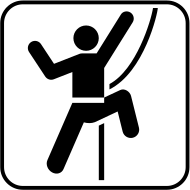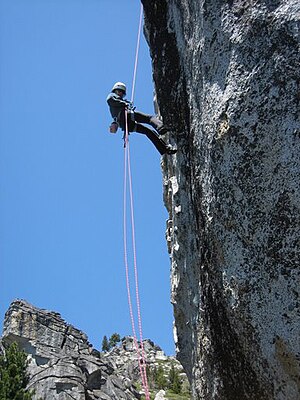Self rescue (climbing)
| Part of a series on |
| Climbing |
|---|
 |
| Background |
| Types |
| Lists |
| Terms |
| Gear |
Self-rescue, in climbing, or in the broader activity of mountaineering, refers to actions and techniques, taken by either an individual climber or teams, to retreat or advance from situations which would leave them, otherwise unprepared, stranded (and, possibly, dead).
Self-rescue is an alternative to calling search and rescue (SAR) which can save the climber(s) being charged for SAR services and can avoid putting SAR team members in harm's way. Unfortunately, many aspiring climbers don't take the opportunity to train themselves in real-life conditions (overhanging edges, etc.) and "find they need to seek outside help".[1]
When members of a team require self-rescue, rescuing a fallen partner may expose the rescuer to significant risks. Self-rescue requires having a practiced rescue plan, good communication, and foresight to avoid "an incident within an incident".[1]
Reasons for self-rescue
Self-rescue techniques can be used to pass a difficult section or to rappel down a multiple-pitch route with an injured climber.[citation needed]
Techniques
Techniques employed during self-rescue include:
- Tandem rappels[citation needed]
- Counterbalance Rappels[citation needed]
- Rescue Spiders[citation needed]
- Rope Soloing[citation needed]
- Multidirectional Anchors[citation needed]
- Belay Escapes[citation needed]
- Rescue Knots[citation needed]
- Ascending Methods[citation needed]
See also
- Glossary of climbing terms
- Glossary of knots common in climbing
- List of climbing topics
- Mountain rescue
References
- ^ a b American Alpine Club (2012). Accidents in North American Mountaineering. Golden, CO USA. p. 85. ISBN 978-1-933056-77-7. ISSN 0065-082X.
Further reading
- David Fasulo, Self-Rescue: How to Rock Climb Series. ISBN 978-0-934641-97-5
- The Mountaineers Books, Mountaineering: The Freedom of the Hills_. 8th Ed. ISBN 978-1-59485-137-7
- Andy Tyson, Molly Loomis. Climbing Self Rescue: Improvising Solutions for Serious Situations. ISBN 978-0-89886-772-5
